Legged bath: features and variety of models
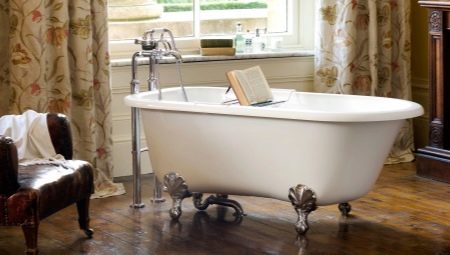
Baroque, classic and renaissance bathrooms often feature elegant clawfoot bathtubs. Such structures are very mobile, can be made in the original design and simply fit elegantly into the rich interior. In this article, you will get acquainted with the peculiarities of using the bathtubs with legs, as well as with the variety of designs of these models.
Advantages and disadvantages
If a professional installs bathtubs on legs, such units can be a chic addition to any bathroom. Despite this, these types of baths have their own advantages and disadvantages, some of which only make themselves felt after long-term use of the unit.
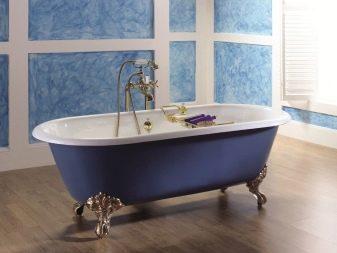
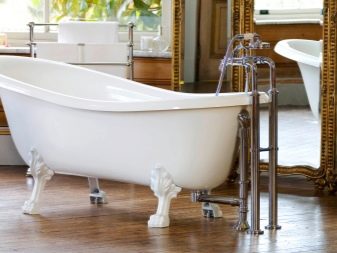
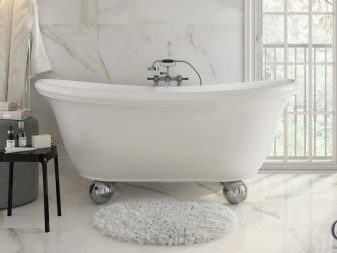
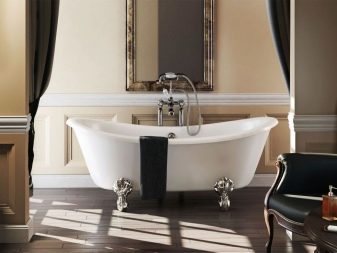
Pros.
- Mobility - this is the main advantage that distinguishes the bathtubs with legs from other models. They can be installed in absolutely any place and at any time moved to another place. This mobility allows you to embody original ideas for bathroom design, where the hot tub is located in the center of the room or conveniently located near the window.
- Models with legs, due to their mobility, can be made in a variety of shapes. Among them there can be round, oval, square and even asymmetrical models.
- In the fastening of standard fonts, only 1 installation method is usually used, while freestanding models can be installed on legs or placed on a special podium. Such structures are usually used to mask communications through which water or electricity is supplied to the font for the Jacuzzi / hydromassage.
- Legged baths are now actively used in the design of bathrooms. in baroque, art deco or classic style, however, when using certain color combinations, the shapes of the legs and the font can perfectly fit into any style solution.
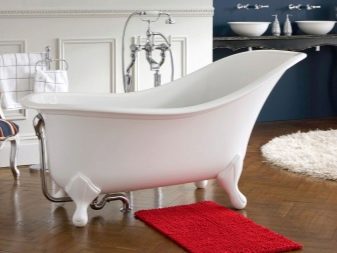
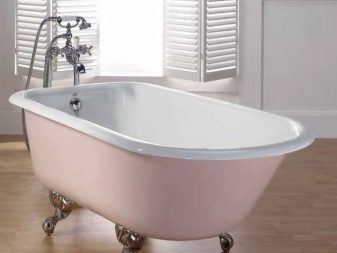


Minuses.
- The classic hot tub can be installed in the bathroom at any stage of the room renovation., detached bathtub models need advance planning, taking into account communications, as well as the size of the structure and the room itself. Due to the need to lay underground communications, such baths are usually advised to be installed in private houses.
- All freestanding bathtubs are heavier than the built-in models. They are usually made of very tough and durable materials capable of providing maximum reliability. The large weight of such fonts forces the owners of the apartment to take fastening more seriously, as well as to the reliability of the floor covering (this especially applies to houses with weak load-bearing walls or wooden floors).
- Price - this is one of the most significant drawbacks of bathtubs with legs - some models can cost twice as much as standard built-in bathtubs. In addition, the installation of such fonts should be entrusted to a specialist, which means additional costs. At the same point, you can designate the huge time costs that go both for the installation of the bath itself, and communications, mixers and other accessories.
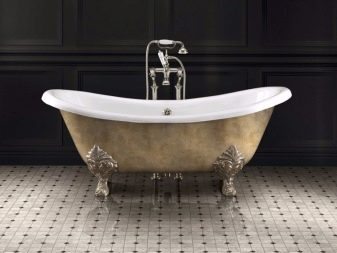
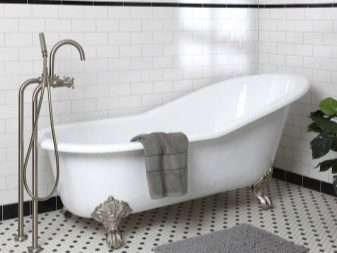
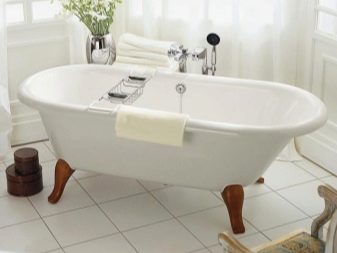
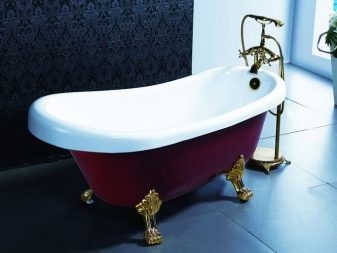
Species overview
All tubs with legs can be divided according to two criteria: according to the material of manufacture and the shape of the font itself.
Depending on the material of manufacture, all baths are divided into:
- metal (from metals and alloys - steel, copper, brass, cast iron);
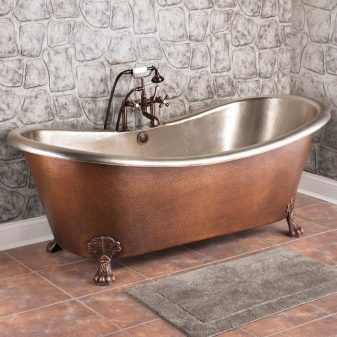
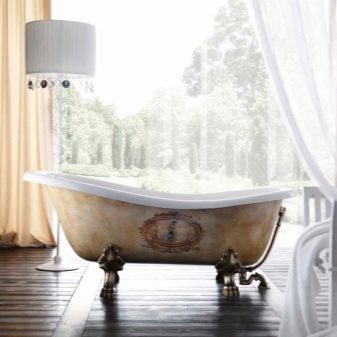
- polymer (quartz and acrylic models);

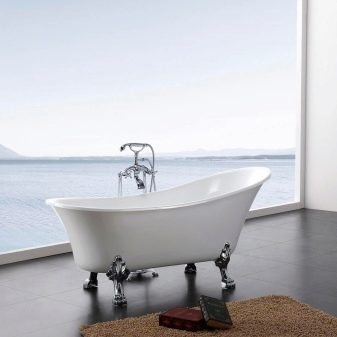
- natural (glass, wood, minerals, marble).


Depending on the shape, all foot baths can be divided into:
- classic oval;
- round or convex;
- square;
- non-standard, including angular and asymmetrical models.

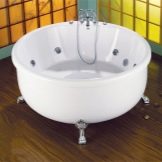
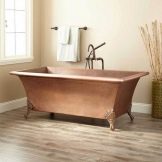
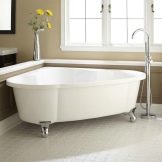
Dimensions (edit)
The standard dimensions of bathtubs with legs do not differ from the dimensions of classic fonts. The adult models of such bathtubs include all models with a length of 150 to 180 cm and a depth of 36 cm or more.
If we are talking about models for small children, then everything here very much depends on the age of the child - usually they buy fonts for babies up to 100 cm in length, and already grown-up children and adolescents can use an adult bath on legs.

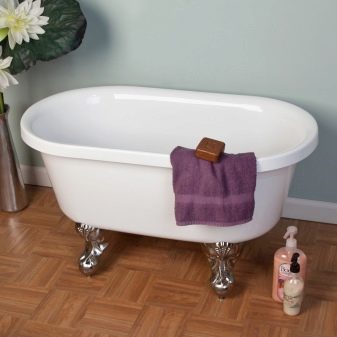
Materials (edit)
Modern clawfoot bathtubs can be made from a wide variety of materials. The choice of material for making a font depends not only on the preferences of the buyer, but also on the style of the room in which the model will be installed.
- Cast iron. Cast iron bathtubs are considered a classic option that has not lost its relevance for over 50 years. These are incredibly durable models that can handle almost any load. Cast iron fonts with legs look extremely harmonious and usually complement classic-style bathrooms.
The most obvious disadvantage of cast iron structures is their huge weight, which forces you to carefully approach the issue of installation, the choice of the stiffness of the legs and the installation site itself.

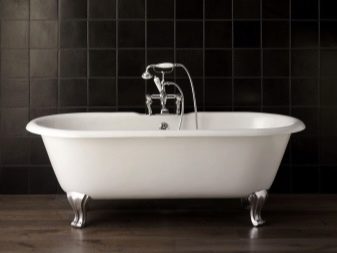
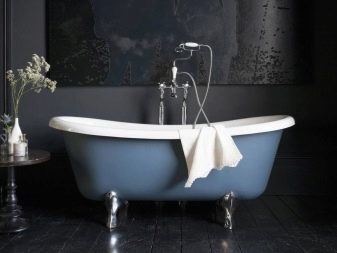
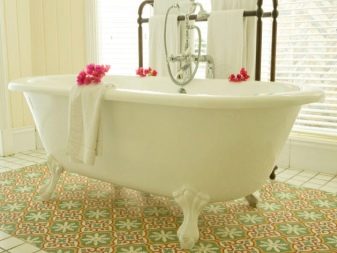
- Acrylic. The most obvious plus of acrylic bathtubs with legs is the huge number of shapes and sizes in which such designs can be made. Acrylic models are very ergonomic, beautiful, easy to clean, have low thermal conductivity and can withstand significant loads. Under ideal conditions, acrylic bathtubs can last up to several decades.
But acrylic also has its drawbacks - it is unstable to very high temperatures, which can be a problem for users who prefer hot baths.
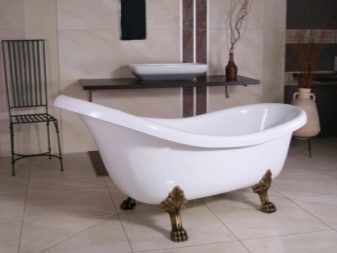

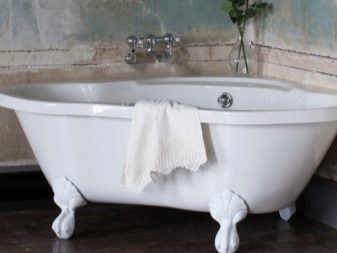
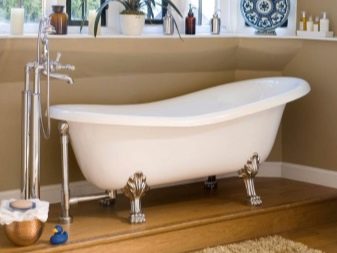
- Steel. Steel models are lightweight, carry loads remarkably, are easy to install, and can also be made in an interesting design.As a minus of steel bathtubs, one can single out a high level of noise, which is observed when filling such models with water, as well as high thermal conductivity.
These models of bathtubs heats up very quickly from the water, but they cool down just as quickly.
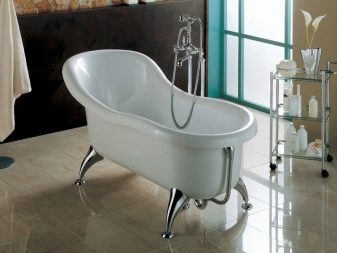
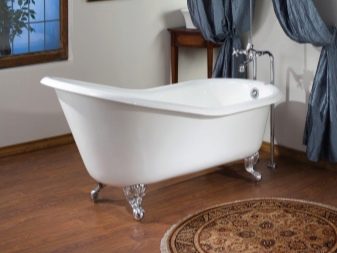
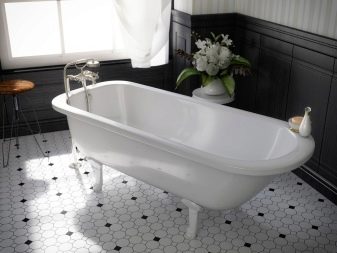
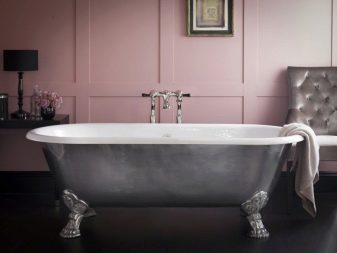
- Kvaril. Quaril-legged bathtubs are just beginning to gain popularity today, but they have already earned a reputation for being very reliable, durable and relatively lightweight structures. Kvaril is a high-strength mixture of quartz and acrylic, which is resistant to corrosion and perfectly tolerates dropping heavy objects.
Quaril fonts are considered an ideal option for sissies who like to spend a lot of time in the bath - the quaril surface retains heat perfectly and does not make noise when drawing water.
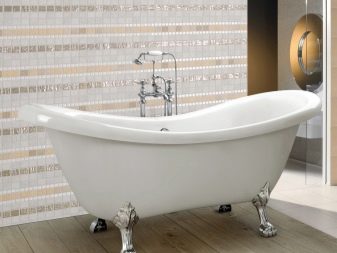
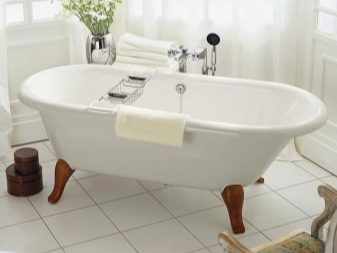
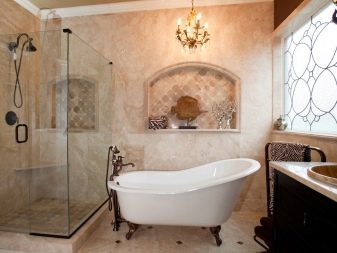
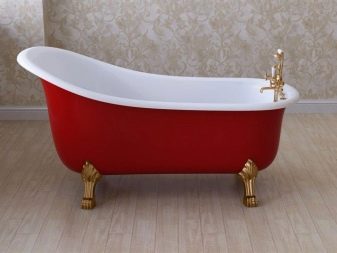
In addition to the materials described above, more rare substances can be used in the manufacture of bathtubs with legs: glass, stone, brass, copper, marble, even wood. Each of them can look very harmonious in a certain style and is matched to a strictly defined style solution.
The downside of such models is the need for careful care, high cost, and also not a particularly rich selection of designs and shapes due to the prevalence of acrylic, cast iron and steel models on the market.
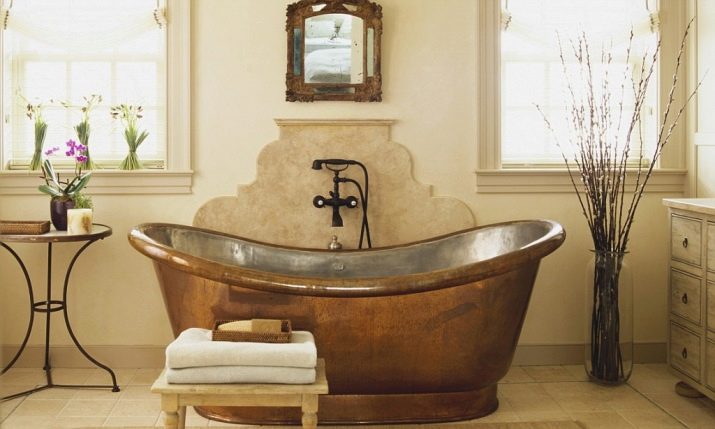
Design options
First, it should be said that, unlike built-in models, freestanding bathtubs with legs can be made in completely different designs. The boundaries of shapes and sizes in this case are very blurred - it can be both classic oval-shaped fonts and round, square options.

Particular attention should be paid to the combination of pedestal bathtubs with different styles.
- Classic style. In the classic style, legged fonts are an irreplaceable element of the interior. Usually there are models of snow-white or cream bathtubs of a standard oval size made of cast iron or acrylic on fancy gold-plated or silver-plated legs. An important addition to them should be expensive gold-plated or silver-plated faucets.


- Retro. When looking at retro-style bathrooms, you can also often see legged hot tubs. Unlike the classic style, these bathtubs can be made in different colors (black, brown, green, red). In this case, the legs for the font can be gilded, covered with silver or any other paint that fits into the color scheme of the room.
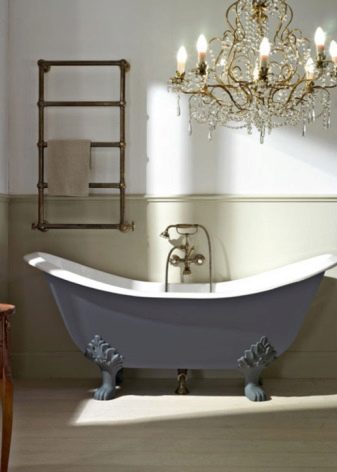
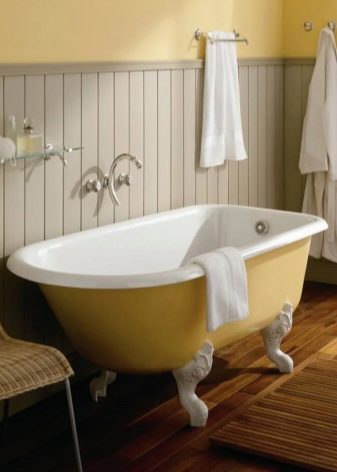
- Minimalism and hi-tech. In these styles, legged structures are practically not found. Everything is explained by the fact that such styles do not tolerate smooth lines and pretentiousness. In rare cases, freestanding models on platforms in black and white can be found here.

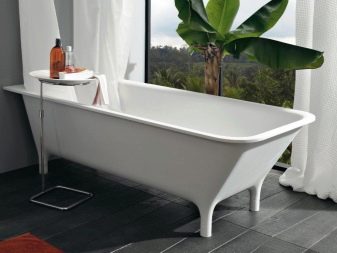
- Renaissance and Baroque... These styles are in many ways reminiscent of the classics, but they involve even more luxurious interior elements and plumbing. There can be fonts made of absolutely any materials, however, they should look rich and be placed on convex gilded legs. In this case, mixers are recommended to be installed strictly according to the color scheme of the room.
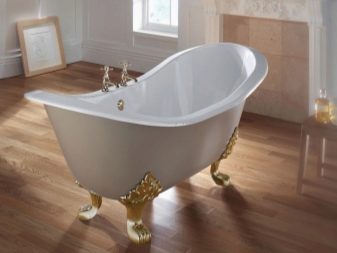
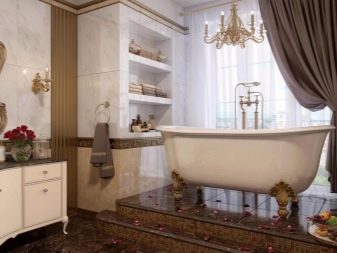
- Victorian... This style is a softened version of the classics - there are not so many luxurious decorative elements, there is no usual gilding and expensive furniture, but there is still its own special luxury. Fonts on platforms or legs also look great here, but they can be made in a wide variety of colors. Most often, calm dark tones like burgundy, purple and gray are used. A feature of this style is a huge number of additional decorative elements that give the room even more sophistication and comfort.
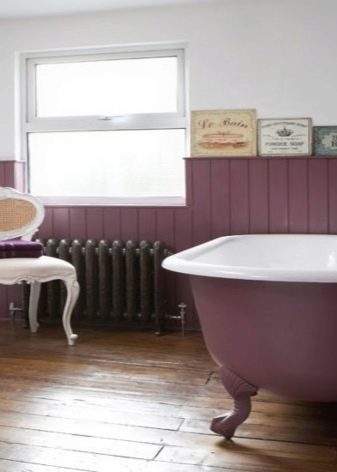

Manufacturers
Among the manufacturers that produce the most affordable pedestal bathtubs, brands such as Grossman, Belbagno (Italy), Besco, Doctor Jet (Russia-Italy), Devon & Devon (Italy), Luxing, Relisan, Riho, Aquastone, Astra For, and Recor (Portugal).
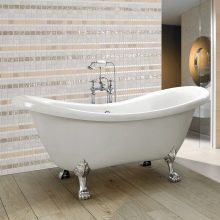
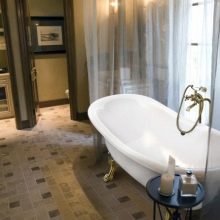
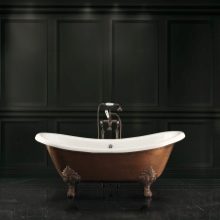
How to choose?
Before you buy a certain model with legs, there are only 2 factors to consider.
- Manufacturing material. If you want to buy a reliable bathtub, it is better to choose cast-iron, stone or quartz models. These materials are reliable, but poor mobility due to their high weight and complex fastening, which do not allow moving these structures from place to place. If you want a more beautiful and stylish model, then consider options from acrylic, copper, glass or brass - these materials do not have the same strength as cast iron, but in certain styles they will be simply irreplaceable.
- Reliability, rigidity and material of manufacture legs for holding a font.

Since the pros and cons of individual materials for making bathtubs have already been discussed above, below you will learn about the rules for choosing feet for a font.
- No matter what material your bathtub is made of, buy leg models exclusively from durable elements that can withstand the weight of a person and water. Most often, bath legs are made of steel, bronze or enamelled iron.
- Please note that raised hot tub models are heavier, therefore, exert an increased load on the floor surface. That is why, in no case should you install freestanding bathtubs in places with cracked tiles.
- Today, bath legs come in three varieties.
- The first variety is purely decorative, it complements the interior of the room, while the font itself is installed on invisible hooks.
- The second is supporting. These legs may not be as beautiful as the decorative ones, but they effectively support the font and effectively distribute its weight.
- Third - auxiliary, these legs are needed for additional support and insurance of the font in certain places.
- Bath legs should be selected based on the style of the font itself, as well as the design of the room.... So, legs in the form of bizarre curved leaves or animal paws will perfectly fit into classic bathrooms.
- Some bath supports can be attached to a special tape, but this mounting option is considered not the most reliable. To get the safest and most reliable pedestal bath, use fixtures that involve brackets, screws, screws and plates.
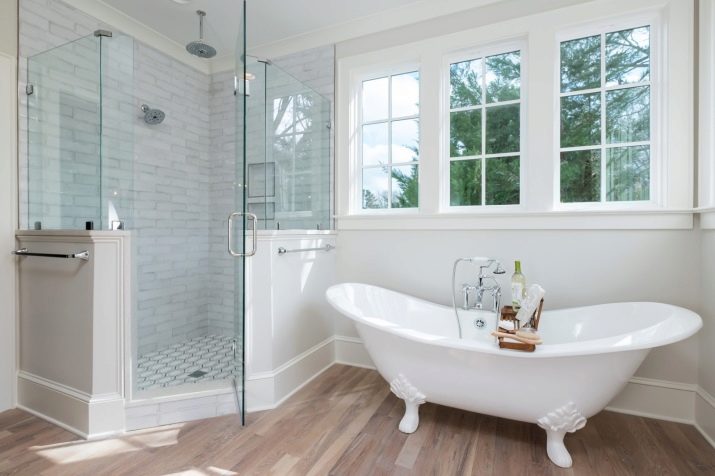
Beautiful examples in the interior
Below you will find beautiful examples of the use of pedestal bathtubs in various styles. Please note that most of the models in the photo are made in white and have graceful gold-plated or silver-plated legs and faucets.
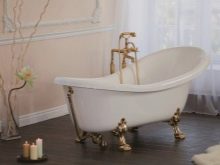
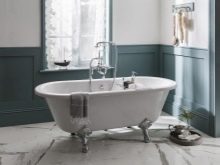
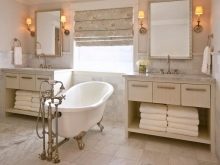
For information on how to install the legs on the bathtub, see the next video.








